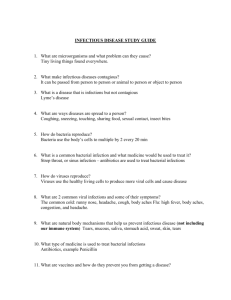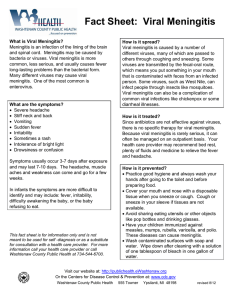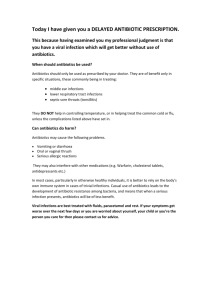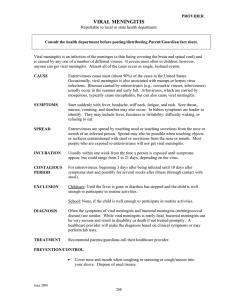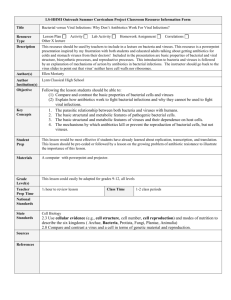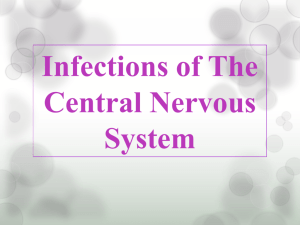How the Clinical Laboratory Enhances Patient Care
advertisement
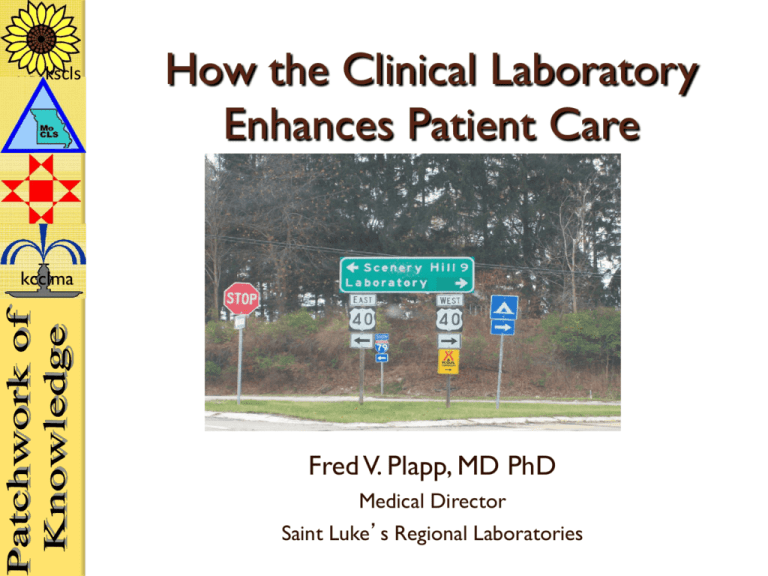
kscls How the Clinical Laboratory Enhances Patient Care kcclma Fred V. Plapp, MD PhD Medical Director Saint Luke’s Regional Laboratories Diagnosis of Meningitis kscls Expediting Patient Care Infection of tissues surrounding the brain & spinal cord Bacterial or viral kcclma ◦ Mostly viral Viral usually mild Bacterial is lifethreatening Diagnosis of Meningitis kscls Traditional Practice Patient presents to Emergency Room Lumbar puncture to collect CSF ◦ Bacterial cultures require 3 days ◦ Viral cultures require 10 days kcclma Patient admitted to hospital Treated with IV antibiotics until likely that bacterial culture will be negative Discharged with outpatient antibiotics kscls Viral Meningitis Traditional Diagnosis kcclma 4 – 10 Days kscls Viral Meningitis Real Time PCR Diagnosis kcclma 1 million viral copies in 30 minutes instead of 10 days kscls New Meningitis Algorithm RT PCR while patient is in ER kcclma Enterovirus Detected Enterovirus Not Detected Discharge Admit to Hospital Meningitis Outcomes kscls Downstream Cost Savings Traditional Approach ◦ ◦ ◦ ◦ kcclma Average LOS is 2.8 days Average hospital charge is $14,050 IV antibiotics during admission Outpatient antibiotics for 10 – 14 days SLH Molecular Approach ◦ Avoid admission if Enterovirus detected ◦ Avoid unnecessary antibiotics Rapid ID of CoNS kscls Improved Antibiotic Stewardship Peptide Nucleic Acid FISH ◦ Non-amplified fluorescent molecular probe Recognizes species specific RNA kcclma ◦ Distinguishes Coagulase Negative Staph from Staph aureus ◦ Advantages Timely & accurate same day results Minimal equipment requirement Other probes for Gram-negatives & yeast ◦ Disadvantages Expensive cost per test Must batch test due to $$$$$ kscls kcclma Rapid ID of CoNS Lab & Pharmacy Cost Savings Culture Alone Culture + PNA Time to ID Antibiotic Dose per Patient 132 hours 5.8 38 hours 2.8 Cost per Patient* $72.02 $14.28 Cost per patient included antibiotics & laboratory tests Rapid ID of CoNS kscls Downstream Cost Savings SLHS performed 23,652 blood cultures in 2009 452 contaminants (1.9%) kcclma ◦ 350 were CoNS Each contaminant adds ~$5000 to cost of hospital stay Rapid ID of CoNS saves ~$1.75M per year by preventing LOS Recombinant rFVIIa Usage kscls Laboratory as a Watchdog Recombinant Factor VIIa (Novoseven) Binds directly to tissue factor & activates FX FDA approved for hemophilia with acquired inhibitor Off label use for acute bleeding kcclma ◦ Very expensive ( $1 per ug) ◦ Short half-life of 2-3 hours ◦ Possible thromboembolic events kscls Reining in the Outlier Surgeon kcclma 1Q09 1Q10 1 $5450 $0 2 $0 $0 3 $0 $0 4 $0 $12,220 5 $98,690 $16,000 Open Heart Surgery kscls Transfusion Review OHS transfused ~one third of components Clinical Pathologist analyzed blood usage each year ◦ Surgeon specific usage ◦ Reviewed with CTS team ◦ Evaluated risk factors, meds,practice variations kcclma Published transfusion guidelines & risks Presented to surgeons, Department Chair, Chief Medical Officer Average Number of Units kscls Transfused per OHS Case 4.5 kcclma Average # Units per Patient 4 3.5 RBC FFP Platelets 3 2.5 2 1.5 1 0.5 0 1990 1991 1992 1993 1994 1995 1996 1997 1998 1999 2000 2001 2002 2003 kscls Benefits of Decreased Transfusion $260,000 cost savings in blood products per year Transfusion reaction risks decreased Blood Bank workload decreased Nursing time for transfusion decreased kcclma Order Sets kscls Ensuring Appropriate Testing Nurses & physicians write order sets Clinical Pathologists review lab tests ◦ Additions, deletions, substitutions kcclma Suggestions returned to authors Order sets published Test utilization monitored before & after 70 Order Sets kscls Impact on Test Utilization kcclma Year Cases/Yr Tests/Cs Test/Yr 1992 8823 50.3 443,797 1996 9630 44.3 426,609 Diff 807 -6 -17,188 % Diff +9% -12% -4% kscls kcclma Inpatient Tests per Discharge 60 50 40 30 20 10 0 75th per centi l e 25th per centi l e 1Q94 1Q95 1Q96 1Q97 1Q98 1Q99 2Q00 1Q01 1Q02 1Q03 1Q04 Specimen in Lab Policy kscls Decreasing Wastage Worked with Blood Management Team to reduce iatrogenic blood loss SIL Policy implemented kcclma ◦ Stored blood specimens for 1 week ◦ Publicized in Lab Letter & Nursing publications ◦ Avoided redrawing patients for add-on testing Specimen in Lab Policy kscls SLH Outcomes 11,244 requests for tests on SIL $51,726 savings in labor & supplies Avoided 11,244 venipunctures Conserved 71,428 mL of blood kcclma ◦ Equivalent to 140 units of RBCs POC Blood Glucose Testing kscls Improving Patient Safety Manual Patient ID entry ◦ 12,000 tests per month ◦ 9.7% average error rate ◦ ~450 unidentified results per month kcclma PI project to reduce errors ◦ Accu-Chek Inform & RALS Plus ◦ Barcoded armbands & handheld devices nFe 02 bM 02 ar -0 A 2 pr M 02 ay Ju 02 n0 Ju 2 lA 02 ug S 02 ep -0 O 2 ct N 02 ov D 02 ec -0 Ja 2 nFe 03 bM 03 ar -0 A 3 pr M 03 ay Ju 03 n0 Ju 3 lA 03 ug S 03 ep -0 O 3 ct N 03 ov D 03 ec -0 3 Ja kcclma Error Rate % kscls Glucose Meter ID Errors 12.0 10.0 8.0 6.0 4.0 2.0 0.0 Test Utilization Ideas kscls kcclma www.clinlabnavigator.com
